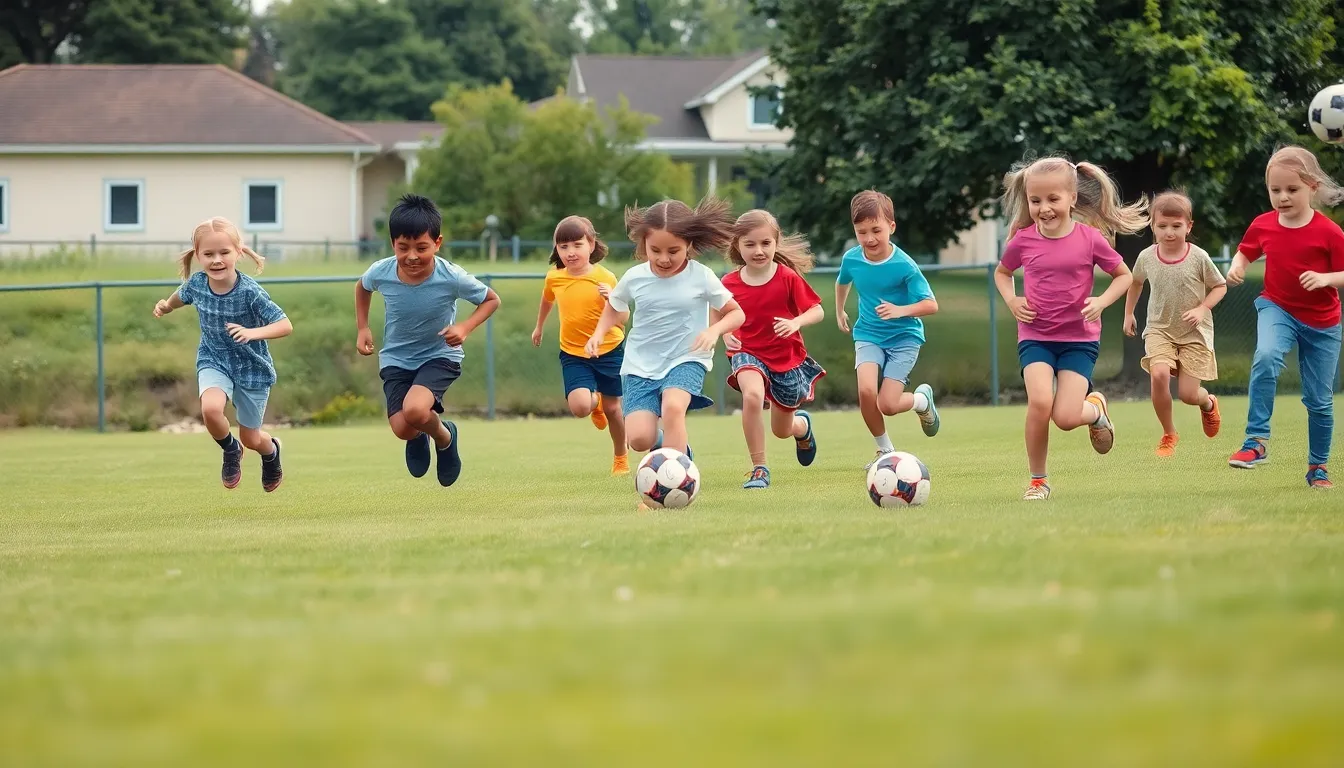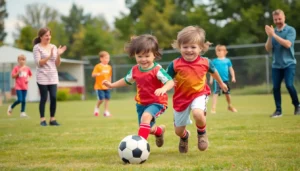Table of Contents
ToggleKids sports aren’t just about scoring goals or hitting home runs; they’re a hilarious mix of teamwork, competition, and the occasional faceplant. Every weekend, parents become cheerleaders, coaches, and sometimes even referees, navigating the wild world of youth athletics. From soccer to basketball, these spirited activities not only keep kids active but also create memories that last a lifetime—like that time little Timmy scored a goal… for the other team.
Importance Of Kids Sports
Kids sports play a crucial role in overall development. These activities contribute significantly to physical and mental well-being.
Physical Benefits
Engaging in sports enhances children’s physical health. Regular participation strengthens muscles and improves cardiovascular fitness. Coordination and balance increase through various sports activities. Weight management becomes easier with elevated physical activity levels. Kids also develop healthy habits that contribute to lifelong fitness.
Mental Benefits
Involvement in sports boosts cognitive function in children. Focus and concentration improve as they learn game strategies. Resilience builds when kids face challenges and setbacks in competition. Social skills develop through teamwork and communication during games. Emotional regulation improves, fostering better coping mechanisms in various situations.
Types Of Kids Sports

Kids sports can be categorized into two main types: individual sports and team sports. Each type offers unique benefits and experiences for young athletes.
Individual Sports
Individual sports emphasize personal achievement and self-discipline. Activities like swimming, gymnastics, and tennis promote unique skill sets. Children develop important traits such as focus and resilience. Competitive settings encourage them to set personal goals, track progress, and perform independently. These sports often suit kids who thrive on personal accountability rather than relying on teammates.
Team Sports
Team sports foster collaboration and camaraderie among participants. Popular options include soccer, basketball, and baseball, where teamwork plays a vital role in success. Kids learn how to communicate effectively and support one another during games. Engaging in team sports enhances social skills and builds friendships that can last a lifetime. This shared experience teaches children valuable lessons about trust and collective effort while having fun.
How To Encourage Participation
Encouraging kids to participate in sports enhances their physical and social development. Parents play a vital role in fostering interest and enthusiasm.
Creating A Positive Environment
Creating a supportive atmosphere boosts kids’ confidence in sports. Celebrating effort rather than focusing solely on results helps nurture a positive mindset. Parents should emphasize enjoyment and camaraderie during practices and games. Encouragement from coaches and peers further reinforces a sense of belonging. Organizing team-building activities can strengthen friendships among players. By providing a safe space for mistakes, children feel comfortable trying new skills. Motivation thrives when kids sense their efforts receive recognition.
Finding The Right Sport
Finding the right sport starts with considering individual interests. Each child possesses unique preferences, so exploring various sports broadens options. Introducing different activities helps identify strengths and weaknesses. Parents can observe and discuss interests to make informed decisions. Participation in local sports clinics and classes exposes kids to diverse experiences. It’s essential to balance their enthusiasm with realistic expectations, ensuring enjoyment remains the priority. Ultimately, kids are more likely to engage fully when they genuinely enjoy the sport they choose.
Safety In Kids Sports
Safety is paramount in kids’ sports. Awareness of potential risks and proactive measures can significantly reduce injury rates.
Common Injuries
Sprains and strains stand out as frequent occurrences in youth athletics. These injuries usually result from overexertion or improper warm-up routines. Fractures may occur during falls or collisions, especially in contact sports. Concussions also pose a risk, particularly in games involving head impacts like football or soccer. Cuts and bruises result from falls and rough play, adding to the common injury list. Parents and coaches must recognize these risks to address concerns effectively.
Prevention Techniques
Implementing injury prevention strategies is essential. Encouraging thorough warm-ups prepares the body for physical activity, reducing risk. Ensuring proper gear and equipment protects against injuries. Regular hydration supports overall health and prevents fatigue. Teaching kids safe play techniques promotes awareness during games and minimizes collisions. Lastly, encouraging rest when needed helps avoid overuse injuries. By adopting these techniques, parents and coaches create a safer environment for children to enjoy sports.
Kids’ sports offer a vibrant blend of laughter and learning that shapes their development. Through participation in both individual and team sports, children gain essential life skills while enjoying physical activity. Parents play a pivotal role in nurturing this experience by fostering a supportive environment that prioritizes enjoyment over competition.
Safety remains a top priority to ensure that kids can thrive without unnecessary risks. By encouraging exploration and understanding each child’s unique interests, families can help cultivate a lifelong passion for sports. Ultimately, the memories made and lessons learned on the field will resonate far beyond the game.






